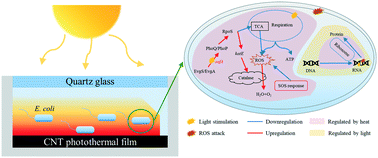Mechanisms of Escherichia coli inactivation during solar-driven photothermal disinfection†
Abstract
Traditional solar water disinfection has low efficiency. Solar-to-heat converting nanomaterials enable the synergy of solar radiation and heat to kill water-borne bacteria. Herein, we explored the mechanism of bacterial inactivation using a solar disinfection reactor based on a carbon nanotube film that converts solar energy to heat. The photothermal reactor showed synergistic enhancement of E. coli inactivation with an efficiency of >5 log inactivation in 20 min under static conditions. The same bactericidal performance can be achieved under continuous flow conditions with a hydraulic retention time of 20 min. Compared with either solar radiation or heat alone, the solar photothermal disinfection treatment induced 2-fold accumulation of reactive oxygen species (ROS) and 40% higher inactivation of catalase and superoxide dismutase. Photo-induced heat was critical in bacterial inactivation. Transcriptomic analysis showed that the synergy of solar radiation and photo-induced heat disrupted the bacterial response to heat stress. Several metabolic pathways related to ROS generation that should be down-regulated by heat stress remained unchanged in sunlight, but the expression of safA (promoting the expression of the gene encoding catalase) was blocked by sunlight, causing the accumulation of ROS. The massive amount of ROS attacked cell membranes and RNA and finally resulted in cell death. This method provides a possible alternative for drinking and reclaimed water disinfection with high efficiency, low energy consumption and no toxic by-products.

- This article is part of the themed collection: Environmental Science: Nano Recent HOT Articles


 Please wait while we load your content...
Please wait while we load your content...